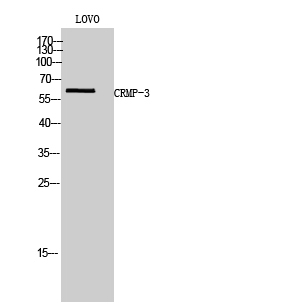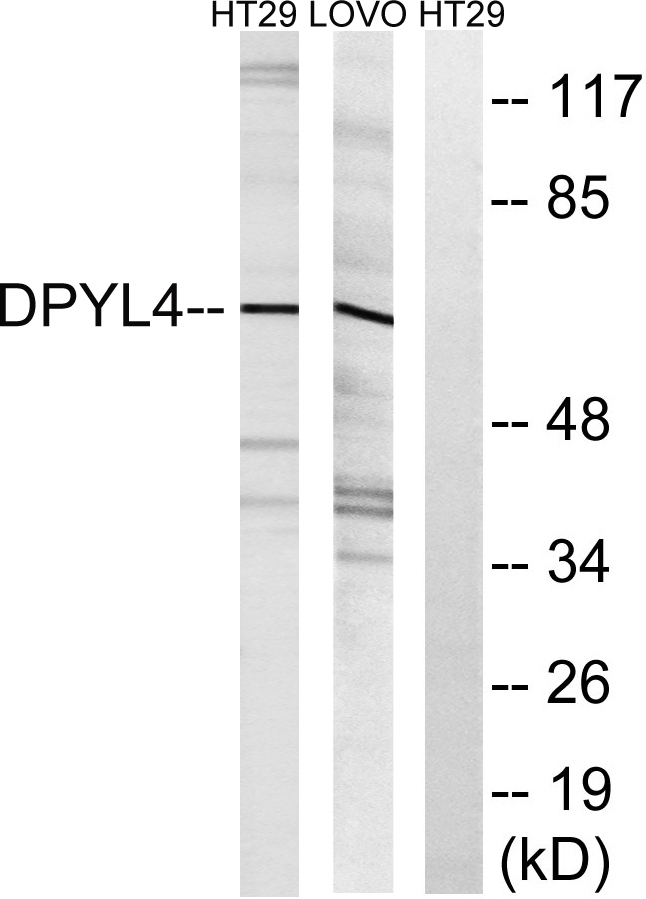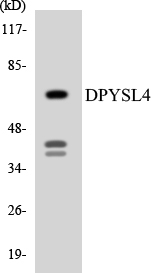CRMP-3 Polyclonal Antibody
- Catalog No.:YT1117
- Applications:WB;ELISA
- Reactivity:Human;Mouse;Rat
- Target:
- CRMP-3
- Gene Name:
- DPYSL4
- Protein Name:
- Dihydropyrimidinase-related protein 4
- Human Gene Id:
- 10570
- Human Swiss Prot No:
- O14531
- Mouse Swiss Prot No:
- O35098
- Rat Gene Id:
- 25417
- Rat Swiss Prot No:
- Q62951
- Immunogen:
- The antiserum was produced against synthesized peptide derived from human DPYSL4. AA range:91-140
- Specificity:
- CRMP-3 Polyclonal Antibody detects endogenous levels of CRMP-3 protein.
- Formulation:
- Liquid in PBS containing 50% glycerol, 0.5% BSA and 0.02% sodium azide.
- Source:
- Polyclonal, Rabbit,IgG
- Dilution:
- WB 1:500 - 1:2000. ELISA: 1:10000. Not yet tested in other applications.
- Purification:
- The antibody was affinity-purified from rabbit antiserum by affinity-chromatography using epitope-specific immunogen.
- Concentration:
- 1 mg/ml
- Storage Stability:
- -15°C to -25°C/1 year(Do not lower than -25°C)
- Other Name:
- DPYSL4;CRMP3;ULIP4;Dihydropyrimidinase-related protein 4;DRP-4;Collapsin response mediator protein 3;CRMP-3;UNC33-like phosphoprotein 4;ULIP-4
- Observed Band(KD):
- 62kD
- Background:
- disease:Antibodies against post-translationally modified DPYSL4, also called anti-CV2 autoantibodies, are present in sera from patients with paraneoplastic neurological diseases (PND). PND are disorders of the nervous system associated with various systemic cancers which are not a direct result of the tumor mass or metastasis, but attributed to remote effects of the cancer.,function:Necessary for signaling by class 3 semaphorins and subsequent remodeling of the cytoskeleton. Plays a role in axon guidance, neuronal growth cone collapse and cell migration.,PTM:Phosphorylated upon DNA damage, probably by ATM or ATR.,similarity:Belongs to the DHOase family. Hydantoinase/dihydropyrimidinase subfamily.,subunit:Homotetramer, and heterotetramer with CRMP1, DPYSL2, DPYSL3 or DPYSL5. Interacts with PLEXA1.,
- Function:
- disease:Antibodies against post-translationally modified DPYSL4, also called anti-CV2 autoantibodies, are present in sera from patients with paraneoplastic neurological diseases (PND). PND are disorders of the nervous system associated with various systemic cancers which are not a direct result of the tumor mass or metastasis, but attributed to remote effects of the cancer.,function:Necessary for signaling by class 3 semaphorins and subsequent remodeling of the cytoskeleton. Plays a role in axon guidance, neuronal growth cone collapse and cell migration.,PTM:Phosphorylated upon DNA damage, probably by ATM or ATR.,similarity:Belongs to the DHOase family. Hydantoinase/dihydropyrimidinase subfamily.,subunit:Homotetramer, and heterotetramer with CRMP1, DPYSL2, DPYSL3 or DPYSL5. Interacts with PLEXA1.,
- Subcellular Location:
- Cytoplasm .
- Expression:
- Brain,Fetal brain,Retina,
- June 19-2018
- WESTERN IMMUNOBLOTTING PROTOCOL
- June 19-2018
- IMMUNOHISTOCHEMISTRY-PARAFFIN PROTOCOL
- June 19-2018
- IMMUNOFLUORESCENCE PROTOCOL
- September 08-2020
- FLOW-CYTOMEYRT-PROTOCOL
- May 20-2022
- Cell-Based ELISA│解您多样本WB检测之困扰
- July 13-2018
- CELL-BASED-ELISA-PROTOCOL-FOR-ACETYL-PROTEIN
- July 13-2018
- CELL-BASED-ELISA-PROTOCOL-FOR-PHOSPHO-PROTEIN
- July 13-2018
- Antibody-FAQs
- Products Images

- Western Blot analysis of LOVO cells using CRMP-3 Polyclonal Antibody

- Western blot analysis of lysates from LOVO and HT-29 cells, using DPYSL4 Antibody. The lane on the right is blocked with the synthesized peptide.

- Western blot analysis of the lysates from RAW264.7cells using DPYSL4 antibody.



